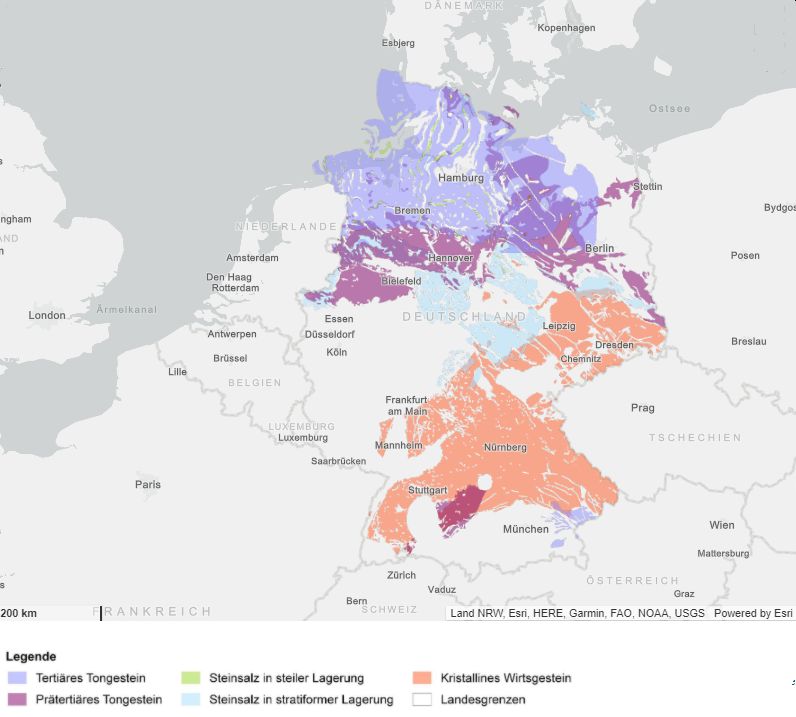High Level Waste disposal siting interim report published in Germany
Our partner organisation, the German Federal Company for Radioactive Waste Disposal (BGE) published its interim report on sub-areas on Monday, September 28, 2020.
The report contains the results of the first evaluation of already existing geological data on the subsurface of Germany. The BGE identifies both those areas that are unsuitable for the final disposal of highly radioactive waste, as well as those that suggest a favourable overall geological situation for the storage of highly radioactive waste. It seems worthwhile to examine these latter areas more closely in the further course of the procedure.
90 sub-areas on 54 percent of Germany's territory
The BGE has identified 90 sub-areas with a total area of over 240,000 square kilometers. Since sub-areas partially overlap, the total area on the formerly white map of Germany is smaller: around 194,000 square kilometers or around 54 percent of the country's territory. “The chance of finding a location in Germany for a repository for high-level radioactive waste that offers security for a million years is very good. This is shown by the 90 sub-areas all over the country, ”says Stefan Studt, Chairman of the Managing Board of the BGE.
Sub-areas in almost all federal states
The sub-areas are spread across all federal states with the exception of Saarland. In claystone, the BGE has identified nine sub-areas with an area of almost 130,000 square kilometers. In the host rock rock salt, a total of 74 sub-areas with an area of just over 30,000 square kilometers have been identified. Seven sub-areas with an area of almost 81,000 square kilometers are located in crystalline host rock. "The size of the sub-areas makes it easy to see that we are still a long way from making a preliminary decision on a location," says Steffen Kanitz, who is responsible for the location selection in the BGE Managing Board.

No preliminary decision on a location yet
The interim report on sub-areas is not a preliminary decision on a possible site for a repository for highly radioactive waste. The goal of the next step in the site selection process is to further limit the search area from sub-areas to siting regions. The BGE will
apply so-called preliminary representative safety studies, the geo-scientific weighing criteria and possibly also spatial planning weighing criteria. Spatial planning weighing criteria include, for example, the population density, nature reserves, water protection areas, floodplain areas or cultural monuments. However, these criteria only come into play if the geological conditions at another comparable site are just as good. After all, the task of the BGE is to find the site that offers the best possible security for a repository for high-level radioactive waste for a million years.
What's next?
In this further course of the first phase of the site selection process, the BGE develops a site proposal for regions that could be explored above ground in phase two, taking into account the results of the public participation in Phase I. The siting regions to be explored are determined by the federal legislature. In phase 2, the BGE then determines sites within the
framework of the surface exploration that it proposes for underground exploration. Once the underground exploration has been completed, the proposed site should be determined by 2031.
About the Site Selection Procedure in Germany
In 2013, the German Bundestag and Bundesrat decided to re-start the search for the site with the best possible safety for a repository for the high-level radioactive waste produced in Germany. The “Commission on the Storage of High-level Radioactive Waste”, consisting of representatives of science, the German Bundestag and Bundesrat as well as associations,
worked until 2016 on a concept for the site selection procedure based on a white map of Germany. For this purpose, the Commission developed rules, criteria and formulated requirements for a repository for high-level radioactive waste. The legislator passed the “Act on the Search and Selection of a Site for a Repository for High-Level Radioactive Waste” (Site Selection Act – StandAG) in May 2017, which was based on the findings of the Commission.
The Site Selection Act describes the search as being based on the principles science-based, participative, transparent, self-questioning and learning. The search area will be narrowed down increasingly over the course of three phases: starting with the entire federal territory; then surface exploration regions and subsurface exploration of sites; and finally a proposal for a repository site offering the best possible safety to accommodate high-level radioactive waste. The Bundesgesellschaft für Endlagerung mbH (BGE) is responsible for the site selection procedure as the German Waste Management Organisation.
The interim report on sub-areas is made available in German on the BGE homepage www.bge.de together with supporting documents and an interactive map.

